If you’ve ever visited Europe, flower-minded or not, you may have returned with enthusiasm for the window boxes they have. Aside from the beautiful winter hanging baskets, perhaps you saw the red geraniums in Germany and Austria, or the tuberous begonias that decorate Switzerland. If you’re planning to festoon your own home with this Old World charm, you’re probably wondering what plants for window boxes work best in your area.
High above the streets of London, Dublin, Copenhagen, Paris, Rome, Vienna, Heidelberg, and Geneva, you’ll find European window boxes. Along the narrow, winding streets of the city, they offer an old fashioned touch of romance throughout the growing season.
Window Box Designs
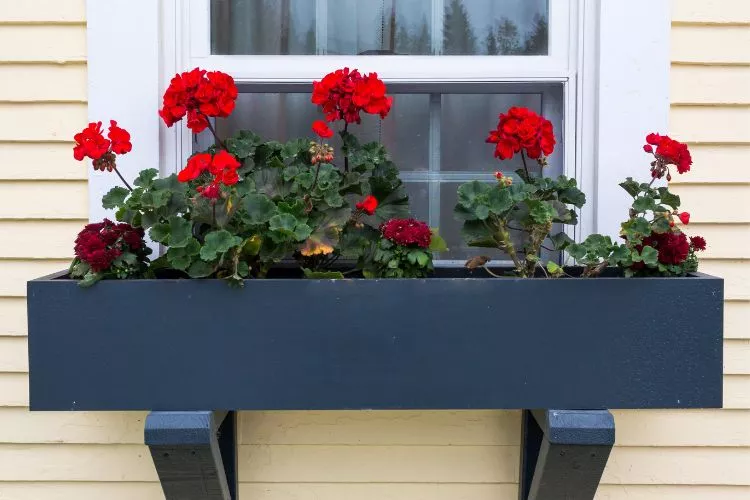
Window boxes are a delightful addition to any home, bringing life, color, and charm to your surroundings. With the right design and selection of plants, you can create stunning displays that change with the seasons.
Window boxes are available in various materials, each with its unique advantages. Common options include wood, metal, plastic, and fiberglass.
The most common material for window boxes is wood. Wooden window boxes offer a natural look. California redwood, which becomes a neutral gray if not painted, and cypress will both last for years. Cedar is often recommended, as is a good grade of white pine.
Metal boxes add durability without weight; however, they have the disadvantage of conducting heat, thus overheating the soil, and potentially killing your plants.
Other suitable and durable lightweight materials are plastic and fiberglass. These window boxes are lightweight and usually the least expensive. However, they become brittle when placed in direct sun.
Size
Consider the dimensions of your window when selecting the appropriate box size. Ideally, the length of the window box should be proportional to the width of the window. The rule of thumb is that it should extend to the window trim on either side for the most attractive proportions.
Aim for a depth of at least 8 inches to accommodate the roots of most plants. Keep to a width of 10 to 12 inches across the top. Remember, if it’s too large, it will be too heavy to suspend and secure properly.
Colors
Window boxes become a striking visual feature when coordinated with the overall color scheme of your home. Choose colors that complement or contrast with your window frames, siding, or trim. Neutral colors like white, black, or earth tones often blend well with various architectural styles. Neutral tones also won’t detract from the plants.
Safe Installation of Window Boxes
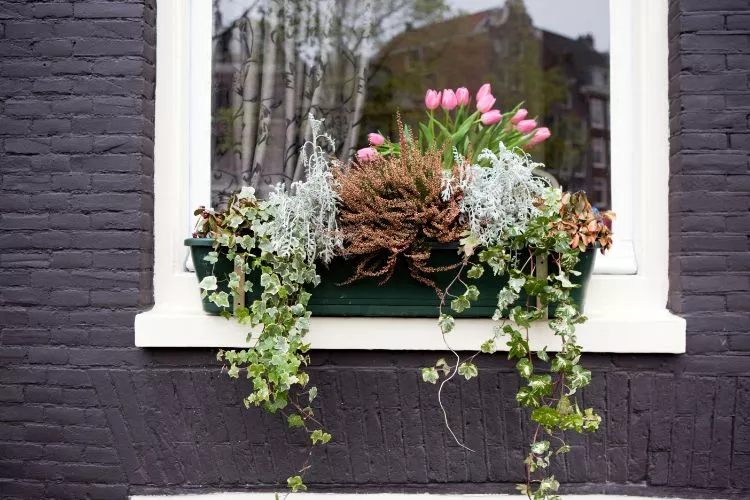
To hold window boxes securely, use bolts or lag screws and treat them with rust inhibitor beforehand. Leave an inch or so of space between box and house for ventilation.
If boxes are to rest on a terrace or other solid surface, raise them on cleats or set up on bricks or blocks of wood so drainage holes won’t become clogged. Some space under boxes is also important for air circulation, which will dry up run-off water.
No Drill Window Boxes
If you’re a renter or otherwise concerned about drilling into the windowsills, no-drill window boxes are an excellent option. These boxes usually feature adjustable brackets or hooks that allow secure attachment to windows without drilling.
Here are a few examples of no-drill window boxes:
Self-Watering Window Boxes: These window boxes feature built-in reservoirs that provide a consistent water supply to the plants. They typically have adjustable brackets or hangers that you can mount onto the window frame or railing. The self-watering feature helps maintain optimal moisture levels for the plants, reducing the frequency of watering.
Window Box Hangers: You’ll find a number of designs for brackets and hangers that support your window boxes over the sill. You won’t have to drill holes or mar the woodwork with this type of no-drill window box.
When using no-drill window boxes, it’s critical that you follow the manufacturer’s installation instructions. Be sure to note and comply with any weight limits. Additionally, regularly check to ensure the box is secure, especially before storms and after freezes.
Choosing the Right Plants for Your Window Boxes
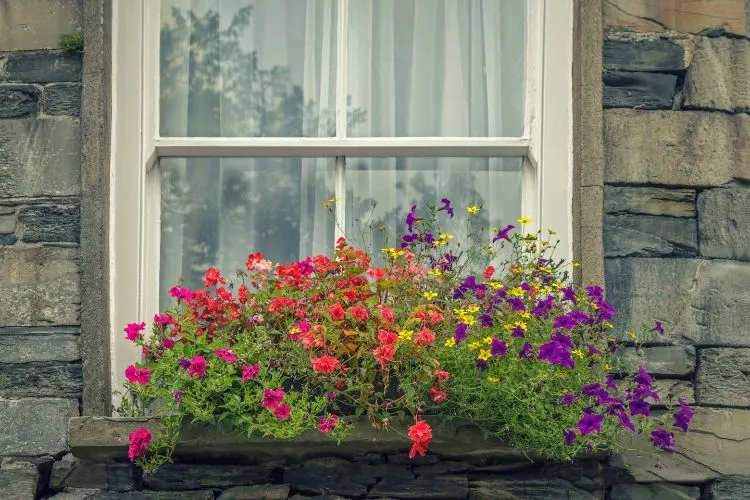
The choice of plants for window boxes is limited only by the season and the placement of your window.
For the most part, follow the standard composition formula for any planter or garden container: “A thriller, a filler, and a spiller.”
To use this formula, you’ll want to choose three types of plants — something showy, something that provides a background for the more flamboyant specimens, and something that will trail over the side.
In the case of a window box, you’ll want to keep everything within proportion – low and wide to follow the profile of the planter.
Next, determine the type of sun exposure your window box receives to help you choose plants that will be happiest in that location.
Best Plants for a Spring Window Box
When planting a spring window box, choose the species according to light requirements:
Full Sun Plants for Spring:
- Tulips (Tulipa spp.): Bright and colorful, tulips provide a burst of spring cheer.
- Daffodils (Narcissus spp.): These hardy flowers come in various shapes and shades, adding a touch of elegance.
- Pansies (Viola spp.): With their cheerful faces, pansies thrive in cooler temperatures and bloom abundantly.
- Grape hyacinth (Muscari spp.): A low-growing bulbous perennial that produces clusters of small, bell-shaped flowers resembling clusters of grapes.
Shade Plants for Spring:
- Impatiens (Impatiens walleriana): These vibrant annuals thrive in shade and produce a profusion of flowers in various shades.
- Begonias (Begonia spp.): Offering a wide range of flower colors and foliage patterns, begonias brighten up shady areas.
- Forget-Me-Nots (Myosotis spp.): These delicate, blue flowers create a charming carpet of color in shaded window boxes.
Trailing Plants for Spring:
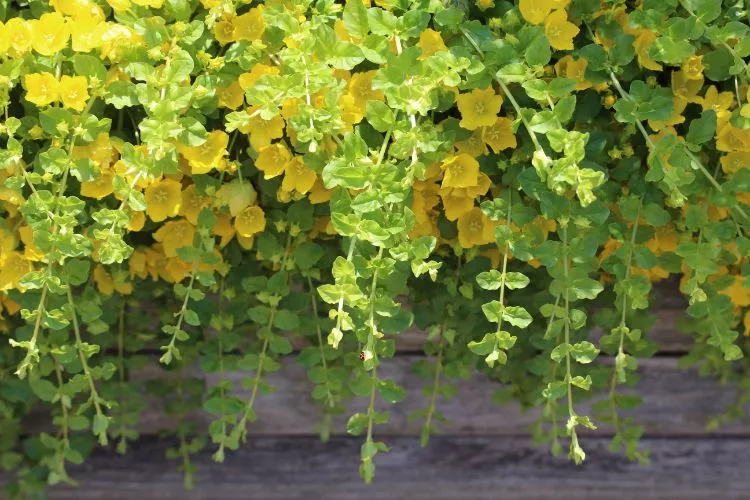
Choose these “spillers” when planting your spring window boxes:
- Creeping Jenny (Lysimachus nummularia): Its trailing habit and golden leaves add a cascading effect to your window boxes.
- Sweet Alyssum (Lobularia maritima): Fragrant and low-growing, sweet alyssum spills over the edges, providing a delicate touch.
Best Plants for Your Summer Window Box
You’ll want to choose more heat tolerant species for your summer window box.
Full Sun Plants for Summer:
- Geraniums (Pelargonium spp.): These classic summer bloomers offer a wide range of colors and are drought-tolerant.
- Petunias (Petunia spp.): With their vibrant and abundant flowers, petunias create a show-stopping display.
- Marigolds (Tagetes spp.): These sun-loving annuals are known for their bold colors and pest-repellent properties.
Shade Plants for Summer:
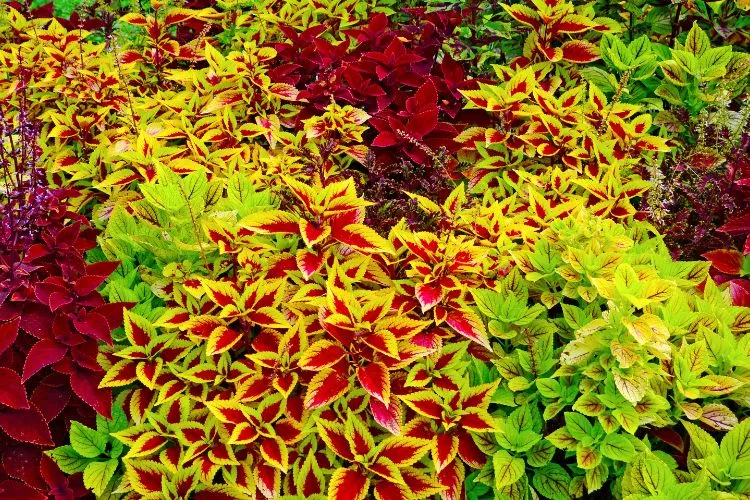
- Coleus (Plectranthus scutellarioides): The colorful foliage of coleus thrives in shade and adds a visual punch.
- Torenia (Torenia fournieri): Also known as wishbone flower, torenia produces charming blooms in shades of blue, pink, and purple.
- Fuchsia (Fuchsia spp.): Offering elegant and pendulous flowers, fuchsias flourish in partial shade.
Trailing Plants for Summer:
These cascading blooms will set off your summer window boxes.
- Lobelia (Lobelia erinus): These delicate flowers come in shades of blue, purple, and white and cascade beautifully.
- Million Bells (Calibrachoa spp.): Resembling mini-petunias, million bells create a profusion of colorful blooms.
Fall Flowers for Window Boxes:
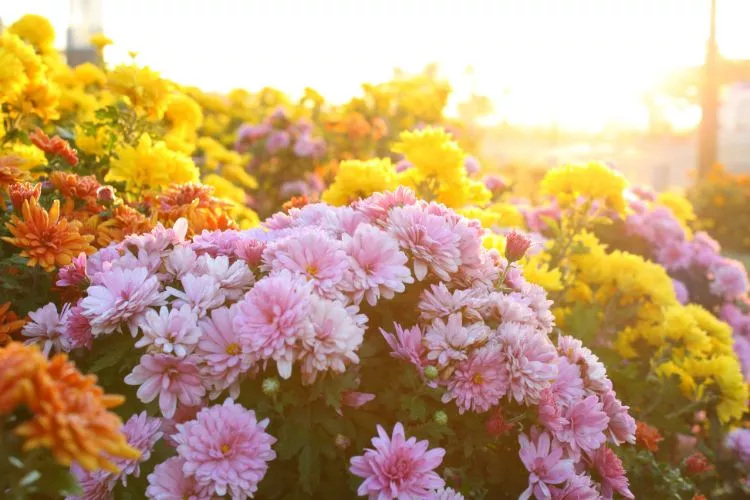
Although the days are getting shorter, there is still plenty of time to plant your fall window boxes.
Full Sun Plants for Fall Window Boxes
These plants look best in the autumn window box:
- Chrysanthemums (Chrysanthemum spp.): Available in various shapes and sizes, chrysanthemums offer vibrant autumnal hues.
- Asters (Aster spp.): These daisy-like flowers come in a range of colors, adding charm to fall window boxes.
- Moss Verbena (Verbena tenuisecta): This low-growing perennial forms a carpet of small, vibrant purple flowers and provides a burst of color in autumn.
Shade Plants for Fall
You’ll still get plenty of fall color in your shady window boxes.
- Heuchera (Heuchera spp.): Offering a range of foliage colors, heuchera adds interest and texture to shade window boxes.
- Ajuga (Ajuga reptans): This low-growing perennial produces beautiful foliage in shades of green, purple, or bronze.
- Japanese Forest Grass (Hakonechloa macra): With its cascading habit and vibrant foliage, this grass adds texture and movement.
Trailing Plants for Fall
Add elegant spillers to the boxes that will thrive in the autumn weather.
- Creeping Thyme (Thymus serpyllum): This aromatic herb creates a dense carpet of foliage and delicate flowers.
- Golden Creeping Jenny (Lysimachia nummularia ‘Aurea’): The golden foliage of this trailing plant brings warmth to fall displays.
Plants for Winter Window Boxes
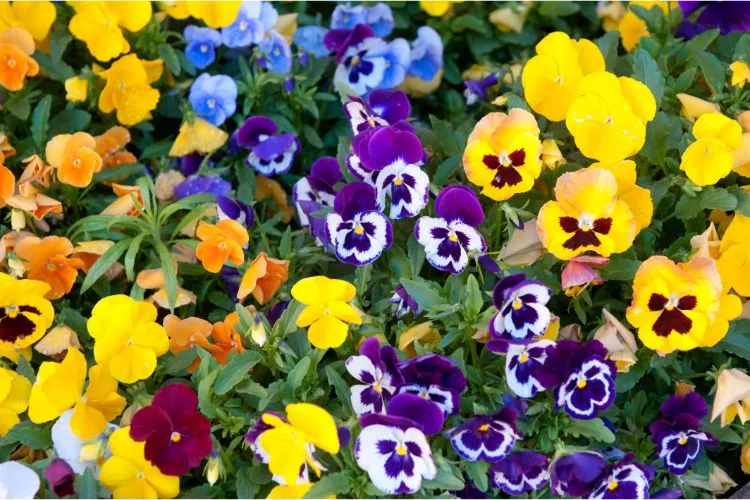
Although winter is not known for vibrant plant growth, there are a few ways to add color to your winter window boxes.
Full Sun Plants for Winter
- Pansies (Viola spp.): These hardy flowers withstand colder temperatures, providing cheerful color during winter.
- Ornamental Cabbage and Kale (Brassica spp.): Their unique foliage colors intensify during the winter months.
- Winter Heather (Erica spp.): Offering blooms in shades of white, pink, and purple, winter heather brings vibrancy to winter window boxes.
Shade Plants for Winter
A few evergreen window box plants prefer a shady spot to thrive.
- Hellebores (Helleborus spp.): These evergreen perennials produce elegant, nodding flowers during winter, tolerating shade well.
- Wintergreen (Gaultheria procumbens): Its glossy leaves and red berries add interest and color to shaded window boxes.
Trailing Plants for Winter:
These trailing plants will bring seasons cheer during the cold months of the year.
- English Ivy (Hedera helix): This evergreen climber provides a lush backdrop and cascades beautifully over the edges of window boxes.
- Vinca Vine (Vinca minor): With its trailing habit and glossy leaves, vinca vine adds a touch of greenery throughout the year.
Winter Window Box Décor
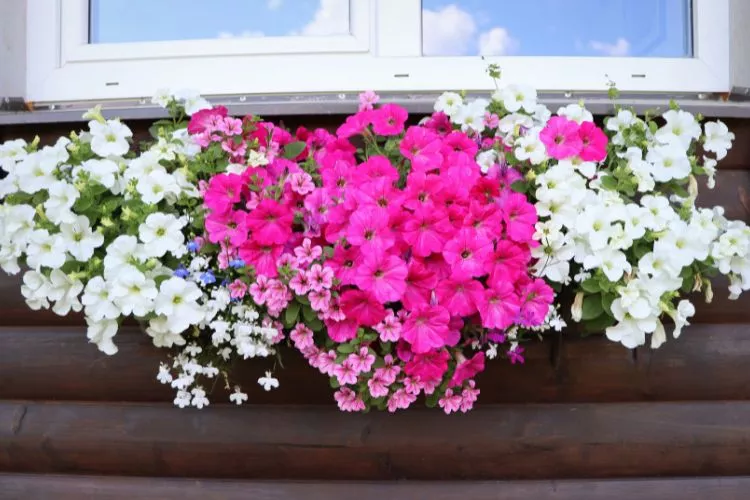
If your climate is particularly chilly or you’d prefer not to have gardening chores in the cold, always decorate your window box over the winter with evergreen boughs.
Add some seasonal color by inserting evergreen branches into the soil. These will last until spring when it is time to set out the first pansies.
Branches of balsam fir, white pine, red, Scotch, or black pines, and Douglas fir stay green all winter.
In warm areas such broad-leaved evergreens as Podocarpus, pittosporum, leucothoe, mahonia, and bull-bay magnolia last several weeks and can be replaced from the abundant supply in the garden.
Add berries to the greenery. Bittersweet is one of the best, but red alder also stays plump and fresh outdoors. Always colorful are California pepper berries, nandina, sea buckthorn, and love apples.
Cones and gilded or silvered seedpods and branches are festive at Christmas, with artificial berries and fruits as other possibilities.
Winter window boxes also make excellent feeding stations for winter birds and other wildlife.
Best Plants for Window Boxes All Year Round:
Even the most avid gardener isn’t always keen on having to replant their window boxes every season. One of the reasons perennials are so popular is because they’re low maintenance and will live from year to year and season to season, providing beauty throughout the year with little maintenance.
If you live in a climate blessed with a mild winter, you may choose to just “plug and play” a few perennials that will provide color in your window box year round.
If you’re in a cooler climate, you can plant hardy perennials that return in spring and bloom till winter. For the colder months, you can allow them to go dormant or provide some seasonal decoration with evergreen branches and berries.
Best Year-Round Evergreen Plants for Full Sun
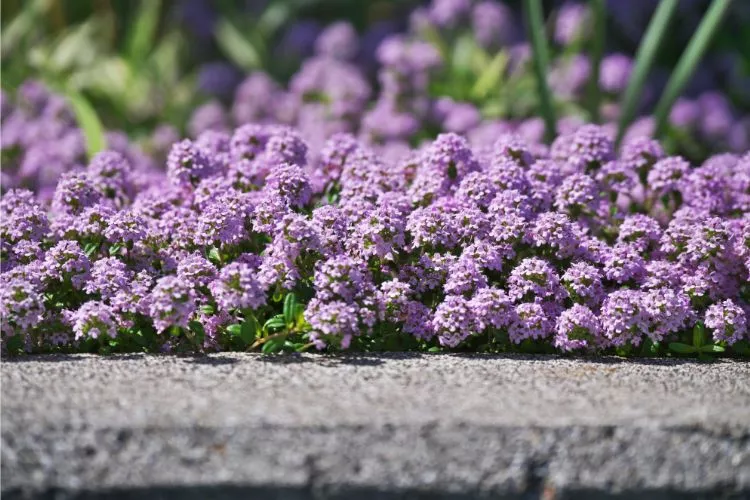
Creeping Thyme (Thymus serpyllum)
Creeping thyme is a popular choice for window boxes due to its aromatic foliage and beautiful carpet-like growth habit. It forms a dense mat of tiny leaves and produces small, delicate flowers in shades of pink, lavender, or white. Creeping thyme is drought-tolerant and thrives in full sun.
Moss Phlox (Phlox subulata)
Moss phlox is a charming evergreen perennial that creates a vibrant carpet of flowers. It produces an abundance of fragrant, five-petaled blossoms in various colors, including pink, purple, white, and blue. It’s heat tolerant and adapts readily to full sun.
Rosemary (Rosmarinus officinalis)
Rosemary offers a wonderful scent and can be pruned to a cascading growth habit, making it a great choice for window boxes. It thrives in full sun and poor soil, as well.
Boxwood (Buxus spp.)
Boxwood shrubs are known for their dense, compact growth and small, glossy leaves. They can be pruned to maintain their desired shape and size, and they add a touch of formal elegance to window boxes.
Juniper (Juniperus spp.)
Junipers are evergreen coniferous plants that offer a range of low-growing varieties suitable for window boxes. They exhibit a wide array of foliage colors, including shades of green, blue, and gold.
Best Year-Round Plants for Shade:
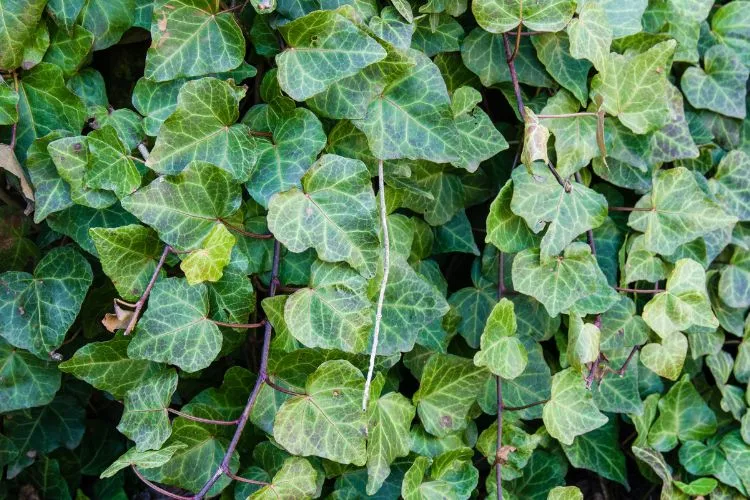
It’s hard to believe that any plant will do well all year round in the shade, but these hardy low-growing evergreens will provide color and interest in every season. Many are evergreen window box plants, while others offer chill resistant trailing foliage.
English Ivy (Hedera helix)
English ivy is a popular choice for shade due to its ability to tolerate low light conditions. It features glossy, dark green leaves that create a lush and cascading effect.
Vinca Minor (Vinca minor)
Vinca minor, commonly known as periwinkle or creeping myrtle, is a shade-loving ground cover with glossy, dark green leaves. It spreads quickly and produces delicate blue or white flowers in the spring.
Japanese Spurge (Pachysandra terminalis)
Japanese spurge is a compact evergreen perennial with glossy, dark green leaves. It forms dense clumps and thrives in shade or partial shade.
Heuchera (Heuchera spp.)
Heuchera, also known as coral bells, is a diverse genus of evergreen perennials. They offer a wide range of foliage colors, including shades of green, purple, silver, and variegated patterns.
Hellebore (Helleborus spp.)
Hellebores, also known as Lenten roses, are evergreen perennials that thrive in partial to full shade. They produce beautiful, cup-shaped flowers in a variety of colors, including white, pink, purple, and green.
Planting Your Window Box
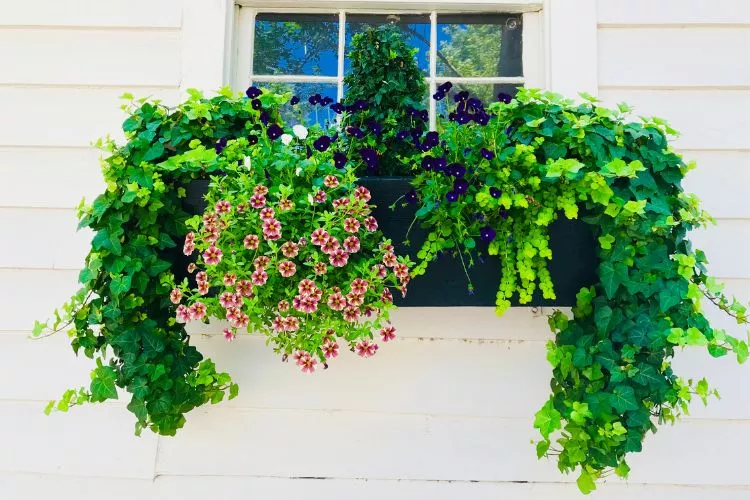
When you plant your window box, place an inch layer of broken flower pots, crushed brick, small stones, or pebbles over the bottom. While this doesn’t improve drainage as many claim, it will help prevent your potting soil from washing out the bottom.
Prepare the Box
Above the layer of rocks or pebbles, spread a piece of wet burlap or a layer of moist sphagnum moss, or old leaves to further help prevent the soil from washing into the drainage area and clogging the drainage holes.
Start by adding a layer of drainage material, such as gravel or broken pottery, at the bottom of the window box to ensure proper water drainage.
Add a layer of burlap, moss, or leaf mold.
Fill the box with a high-quality potting mix, leaving enough space for the plants’ roots. Plants in boxes need rich soil for luxuriant growth. Choose a potting mix that includes amendments to retain moisture and mix in a slow-release fertilizer.
Add Your Plants
- Choose plants with similar watering and light requirements together for ease of care.
- Gently remove the plants from their nursery pots, loosen the roots, and plant them at the appropriate spacing, ensuring they are at the same depth as they were in their original containers.
- Arrange your selected plants in the box, considering their height, growth habit, and sun/shade requirements.
- Place taller plants towards the back and center. Create a focal point by placing taller or more vibrant plants (the “thrillers”) in the center or towards the back.
- Place trailing plants near the edges to soften the box’s appearance and create a cascading effect.
- Combine different plant shapes, textures, and colors to create visual interest. However, it’s important to limit the type of plants to no more than 3 or 5 in one box (depending on the size of the window box) to prevent it from looking too chaotic.
- Repeating plants in the same box and from box to box is what gives garden spaces that “designed” feel. Repetition of plant species or several species of the same color family provide a cohesive look to the garden. The same is true of container gardens, and of window boxes.
- Step back periodically to assess the overall composition and make any necessary adjustments.
- Once all the plants are in place, fill any remaining gaps with additional potting mix, firming it gently around the roots.
- Water the window box thoroughly to settle the soil around the plants’ roots.
- Mulch the top of the soil thickly (about 1.5 inches) to help retain moisture.
Window Box Flowers Ideas
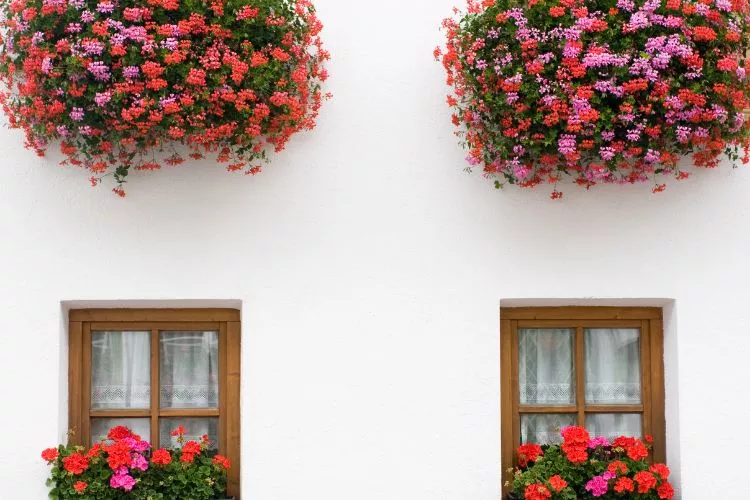
If you’re stumped for ideas of what plants for window boxes will look best, here are some stunning combinations we’ve seen in the past:
Shade-Loving Window Box Plants
- Caladiums with heart-leaved philodendron
- Ferns and coleus with English Ivy
- Tuberous begonias and English ivy
- Pink or red wax begonias and vinca
- Coleus and Tradescantia zebrina ‘Burgundy’
- Upright fuchsias with Purple Heart tradescantia
Plants for Window Boxes in Full Sun
- Calendula with Dwarf marigolds and vinca
- Red geraniums with lobelia and vinca
- Petunias with verbenas and ipomea
- White geraniums with dwarf salvia and lobelia
Summer Home for House Plants
Another way to use window boxes is to offer your houseplants a summering-out place. If your window boxes offer plenty of shade and protection from the scalding sun, your houseplants will enjoy the warmth and humidity.
You can rest the pots directly in the window boxes and anchor them with rocks or coconut coir. Heart-leaved philodendrons, spider plants, and pothos all make excellent trailers.
Other house plants suitable for outdoor boxes include ferns, small dracaenas, alocasias, prayer plants, and bromeliads
Conclusion
Window boxes are an excellent way to highlight the beauty of nature and enhance your home’s appeal throughout the seasons. By carefully selecting suitable plants for each season, you can create stunning displays that bring joy to both you and your neighbors.
Remember to consider factors such as sun and shade requirements, trailing habits, and maintenance needs when choosing and arranging plants for window boxes. With proper care and attention, your window boxes will be a delightful feature that transforms your home with Old World charm.
Editor’s Note: This post was originally published on Nov 24, 2011, and has been completely updated.

I am so thrilled I stumbled upon your site. I really found you by mistake, while I was browsing on Yahoo for something else. Anyways I am here now and would just like to say thank you for a tremendous post and an all round inspiring blog. (I also love the theme/design), I don’t have time to read through it all at the minute, but I have added your website to my favorites, so when I have time I will be back to read more. Please do keep up the awesome job!
A pleasing pair consists of wax begonias and wandering Jew, and these can be rooted .
What else can I plant with dark leaf wax begonias in a window box?
Thank you for another informative site. Where else could I am getting that type
of info written in such an ideal method? I have a project that I am simply now running on, and
I have been at the glance out for such info.
What’s up to every body, it’s my first pay a visit of this webpage;
this website contains amazing and really good information designed for visitors.